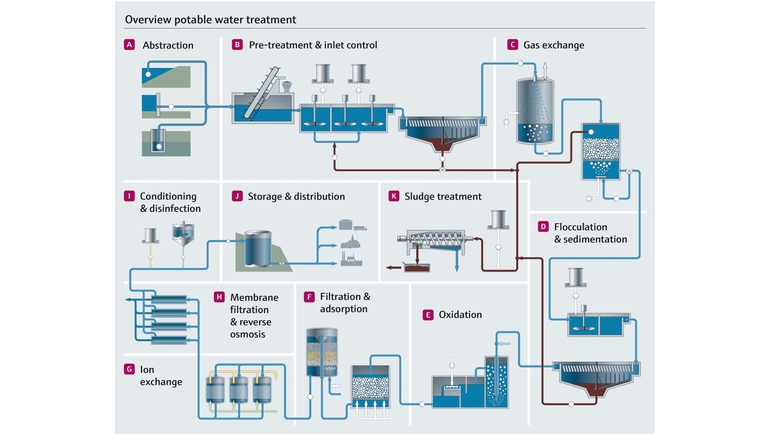The Buzz on In Home Water Filter Systems
Table of ContentsThe 10-Second Trick For In Home Water Filter SystemsThe 6-Second Trick For In Home Water Filter SystemsThings about In Home Water Filter SystemsIn Home Water Filter Systems Fundamentals Explained
A phosphorous compound is included in help control deterioration of pipelines. This assists protect against lead and also copper that might exist in pipes from leaching into the water. As the water leaves the plant, ammonia is added to alter the chlorine to chloramine, a disinfectant that maintains a residual in the distribution system against bacterial contamination.All chemicals that are included are accredited food quality, secure for usage in foods. Dealt with water is saved in deep underground storage tanks as well as likewise moves by gravity to pumping terminals as well as into the circulation system. The circulation system consists of 1,960 miles of water keys ranging in size from 4" to 60".
Elimination of preference as well as smell substances from the water.: Softens the water.: Filtering to remove small bits and sanitation to eliminate viruses and bacteria, and ensure an inappropriate environment for infection and microorganisms development throughout the circulation system.
8 Phases of the Wastewater Process Phase One Bar Screening Removal of large things from the influent to avoid damage to the center's pumps, shutoffs and various other tools. The process of dealing with and also reclaiming water from wastewater (any type of water that has been used in houses, such as flushing bathrooms, washing recipes, or showering, as well as some water from industrial usage as well as tornado sewage systems) begins with the expectation that after it is treated it will certainly be tidy adequate to reenter the atmosphere.
Getting The In Home Water Filter Systems To Work
According to the EPA, The Tidy Water Act (CWA) develops the fundamental structure for controling discharges of contaminants right into the waters of the United States and controling quality standards for surface waters. Under the CWA, EPA establishes wastewater standards for market. The EPA has actually likewise created national water high quality standards recommendations for contaminants in surface waters (in home water filter systems).

Associated White Papers Select Products Stage Two Screening Removal of grit by streaming the influent over/through a grit chamber. Great grit that finds its way right into the influent demands to be removed to stop the damages of pumps and also devices downstream (or influence water flow). Also tiny to be screened out, this grit requires to be gotten rid of from the grit chamber.
Phase Four Oygenation Air is pumped into the aeration tank/basin to urge conversion of NH3 to NO3 and provide oxygen for microorganisms to proceed to multiply and also grow. When converted to NO3, the germs remove/strip oxygen particles from the nitrate particles and the nitrogen (N) is provided off in home water filter systems as N2 (nitrogen gas).
This starts in the aeration storage tank. The primary feature of the oygenation storage tank is to pump oxygen right into the storage tank to urge the break down of any organic product (and the development of the microorganisms), in addition to make certain there suffices time for the natural material to be broken down.
Little Known Facts About In Home Water Filter Systems.

Stage Five Second Clarifier Dealt with wastewater is pumped into an additional clarifier to enable any kind of remaining organic sediment to clear up out of cured water flow. As the influent exits the aeration process, it flows right into an additional clarifier where, like the primary clarifier, any kind of very little solids (or penalties) sink to the base of the container.
Part of this activated sludge is returned to the oygenation storage tank to raise the bacterial concentration, aid in propagation, and also increase the breakdown of organic material. The excess is disposed of. The water that moves from the secondary clarifier has substantially reduced organic material and should be approaching expected effluent specs.
With the improved concentration of bacteria as component of the oygenation stage, there is a demand to test the outbound effluent for microorganisms visibility or lack and also to decontaminate the water. This guarantees that greater than defined concentrations of bacteria are not released right into the atmosphere. Chlorination is the most usual and economical kind of sanitation yet ozone as well as UV disinfection are also enhancing in popularity.
Some Ideas on In Home Water Filter Systems You Should Know
Water is routed from the Head Tank to the Claricone clarifier. in home water filter systems. Water gets in the clarifier at the mixing area located in all-time low of the Claricone. Lime is included in the water in this area where it reacts with the calcium and the magnesium in the water to form precipitates.
After adequate time, bits stick to each other and grow into bigger particles, or, floc, which is prone to work out in water. Information of water is completed by the seperation of put on hold solids from water by gravity.
The made clear water moves upward gradually, eventually passing over the effluent weir to the cone outlet and on the to filters for additional therapy. The water plant incorporates a single stage lime softening operation to eliminate solidity. Firmness is brought on by the visibility see this website of liquified bivalent as well as polyvalent metal ions, primarily calcium as well as magnesium.
This is added both in the clearwell as well as the high service discharge Read Full Report as water gets in the distribution system (in home water filter systems). Hydrofluosilicic acid provides the source of fluoride, which is useful in the prevention of dental caries in children. A fluoride concentration of 1. 1-1. 2 mg/l is typically preferable in the plant faucet.